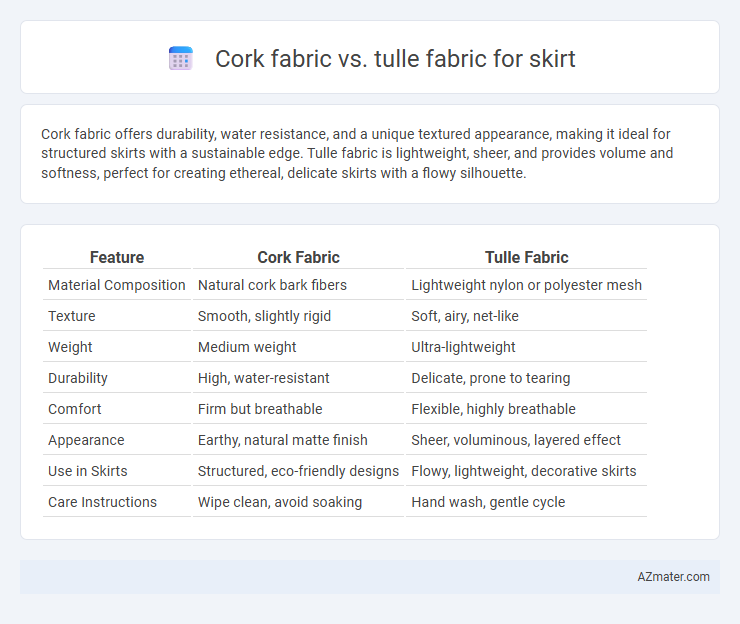Cork fabric offers durability, water resistance, and a unique textured appearance, making it ideal for structured skirts with a sustainable edge. Tulle fabric is lightweight, sheer, and provides volume and softness, perfect for creating ethereal, delicate skirts with a flowy silhouette.
Table of Comparison
| Feature | Cork Fabric | Tulle Fabric |
|---|---|---|
| Material Composition | Natural cork bark fibers | Lightweight nylon or polyester mesh |
| Texture | Smooth, slightly rigid | Soft, airy, net-like |
| Weight | Medium weight | Ultra-lightweight |
| Durability | High, water-resistant | Delicate, prone to tearing |
| Comfort | Firm but breathable | Flexible, highly breathable |
| Appearance | Earthy, natural matte finish | Sheer, voluminous, layered effect |
| Use in Skirts | Structured, eco-friendly designs | Flowy, lightweight, decorative skirts |
| Care Instructions | Wipe clean, avoid soaking | Hand wash, gentle cycle |
Introduction to Cork Fabric and Tulle Fabric
Cork fabric is a sustainable, eco-friendly material made from the bark of cork oak trees, known for its durability, water resistance, and unique textured appearance, making it ideal for statement skirts with a natural aesthetic. Tulle fabric, composed of fine netting usually made from nylon or polyester, offers a lightweight, sheer, and airy quality, perfect for creating layered, voluminous skirts with a delicate and ethereal look. Both fabrics provide distinct textures and visual effects, with cork fabric emphasizing sturdiness and eco-consciousness, while tulle prioritizes softness and transparency.
Origins and Production Methods
Cork fabric, made from the bark of cork oak trees primarily found in Portugal and Spain, involves a sustainable harvesting process where the bark is carefully stripped without harming the tree, then treated and laminated onto a textile backing for flexibility and durability. Tulle fabric originates from the 18th-century city of Tulle in France and is produced using a delicate netting technique on a warp knitting loom, often crafted from nylon, silk, or polyester fibers to create lightweight and sheer textile ideal for skirts. The distinct production methods--natural cork bark transformation versus fine synthetic or silk netting--define their unique textures and applications in skirt design.
Texture and Visual Appeal
Cork fabric offers a smooth yet slightly textured surface with a natural, matte finish, giving skirts a unique, eco-friendly aesthetic that exudes understated elegance. Tulle fabric, characterized by its lightweight, sheer mesh texture, provides a delicate, airy look that adds volume and a whimsical visual appeal to skirts. The contrast between cork's solid, structured feel and tulle's soft, translucent quality highlights different stylistic choices for skirt designs.
Durability and Maintenance
Cork fabric offers exceptional durability, resisting wear and tear better than delicate tulle, making it ideal for long-lasting skirts. Its water-resistant and easy-to-clean surface requires minimal maintenance compared to tulle, which is prone to snagging and often needs gentle hand washing or dry cleaning. Choosing cork fabric ensures a sturdy skirt with simple upkeep, while tulle demands careful handling to maintain its lightweight and sheer appearance.
Breathability and Comfort
Cork fabric offers moderate breathability and is known for its durability and water-resistant properties, making it less breathable but comfortable in cooler climates. Tulle fabric excels in breathability due to its lightweight, sheer mesh structure, providing maximum airflow and comfort, especially in warm weather. When choosing between cork and tulle fabrics for skirts, tulle is ideal for enhanced ventilation and lightness, while cork suits structured, weather-resistant styles.
Eco-Friendliness and Sustainability
Cork fabric is highly eco-friendly due to its renewable sourcing from cork oak trees without harming the bark, making it biodegradable and sustainable for skirt production. Tulle fabric, often made from synthetic fibers like nylon or polyester, has a larger environmental footprint due to reliance on petrochemicals and slower decomposition rates. Choosing cork fabric for skirts supports sustainable fashion by reducing plastic waste and promoting natural material use.
Styling Flexibility for Skirt Designs
Cork fabric offers a unique, eco-friendly texture with excellent durability and structure, making it ideal for sculptural and statement skirt designs that maintain form. Tulle fabric provides lightweight, ethereal volume with its sheer and breathable qualities, perfect for layered, flowy skirts that emphasize softness and movement. Skirt designs benefit from cork's rigidity for bold silhouettes, while tulle enhances femininity and layering versatility in fashion styling.
Cost and Accessibility
Cork fabric is generally more expensive and less accessible due to its niche production and eco-friendly sourcing, making it a premium choice for skirts. Tulle fabric is widely available and budget-friendly, commonly found in craft stores and fabric outlets, offering easy accessibility for various skirt designs. Cost-effectiveness and fabric availability often make tulle the preferred option for affordable and readily accessible skirt materials.
Suitability for Different Occasions
Cork fabric offers a unique, eco-friendly texture suitable for casual and semi-formal skirts, providing durability and a natural appearance that complements outdoor or creative event settings. Tulle fabric, known for its lightweight, sheer, and voluminous qualities, is ideal for formal occasions, such as weddings and parties, where an elegant and airy aesthetic is desired. The choice between cork and tulle depends on the desired look and event formality, with cork emphasizing sustainability and structure, while tulle excels in creating delicate, romantic silhouettes.
Final Comparison: Which Fabric Wins for Skirts?
Cork fabric offers durability, eco-friendliness, and a unique textured aesthetic, making it ideal for structured, standout skirts, whereas tulle provides lightweight, sheer elegance perfect for flowy, delicate skirt designs. Skirts made from cork fabric excel in longevity and water resistance, while tulle skirts shine in volume and breathability. For sustainable fashion with a bold statement, cork fabric wins, but for airy, romantic styles, tulle remains the preferred choice.

Infographic: Cork fabric vs Tulle fabric for Skirt
 azmater.com
azmater.com